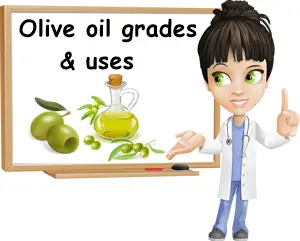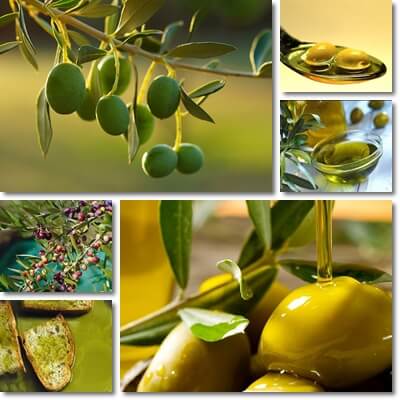Olive oil is the face of healthy eating and healthy living. It is the one vegetable oil publicly associated with cardiovascular health and increased longevity.
But not all olive oil is the same. There are actually different types of olive oil, classified according to quality or grade, extraction method, freshness, purity, country or region of origin and use.
Only a few of these can be considered healthful foods and sources of health benefits. Find out what are the different types of olive oil and which is the best olive oil to eat and use, fresh or for cooking or cosmetic purposes.
What is olive oil?
Olive oil is an edible culinary oil made from olives. It is a carrier oil or base oil and can be used both fresh and for cooking, as well as for cosmetic purposes.
Olive oil is 100% fat, more exactly 84% unsaturated fat and 14% saturated fat, with the exact fatty acids composition varying from oil to oil, season to season, according to olive variety, fruit ripeness, time of harvest, weather conditions, region, even altitude and especially extraction method and processing undergone.
Olive oil has many uses, the most popular being culinary oil, including cooking oil, cosmetic and soap oil and functional food.
Ideally, the oil should have a golden color, with a green tinge, and taste faintly bitter or even peppery, with grassy-green flavors and even fruity notes (if the olives are riper) and a grassy-green odor reminiscent of green olives (not the same as the smell of cured or canned olives).
It is important to remember that oil quality, color and other characteristics are not determined (solely) by region or country of origin.

Fatty acids profile of olive oil
- Olive oil: types of fat
- Omega 9: 55% to 83% oleic acid (monounsaturated)
- Omega 6: 3.5% to 21% linoleic acid (polyunsaturated)
- Palmitic acid: 7.5% to 21% (saturated fat)
- Stearic acid: 0.5% to 5% (saturated fat)
- Omega 3 (ALA/alpha linolenic acid): 0% to 1.5% (polyunsaturated)
- Squalene (a fat also found in sharks and human sebum composition) : less than 1%
- Sterols (phytosterols and others): 0.2%
- Other fatty acids
As you can see from the fatty acids profile, olive oil is not all the same. While there are the same types of fat in it, the fat composition of olive oil can vary greatly.
The only constant is that it’s all made from the same raw material, olive pulp, and thus shares some common characteristics.
As a result, there are quite a lot of differences between the various types of olive oil, from flavor profile, color and looks in general to antioxidant profile and even edibility.
See below what are the different types of olive oil according to quality (grade) and how they compare with one another in terms of edibility, uses, benefits and side effects:
Type 1: Unfiltered olive oil
It is also known as ‘olio novo’, which means ‘new oil’ in Italian, or cloudy olive oil due to the presence of fruit particles. It is the first edible olive oil resulting from the processing of olives for oil extraction.
Unfiltered olive oil is a type of cold-pressed, minimally processed, first-press olive oil, and is extravirgin grade. As its names suggest, it is unfiltered, meaning it retains small fruit particles which causes a visible cloudiness in the oil, hence the name ‘cloudy’.
While some consider it to be an intermediate product, that is, not yet ready for consumption, unfiltered olive oil is perfectly edible and safe to eat, both fresh and lightly cooked (so as to not alter its flavor profile and properties).
However, the lack of filtration is not just an aesthetics issue. While this type of olive oil is of the highest grade (extravirgin), it also has the disadvantage of spoiling faster because the olive particles in it may ferment which both increases the oil free acidity (ruining its extravirgin olive oil quality), and reduces shelf life, causing faster spoilage.
If you do buy unfiltered olive oil, know that it is highest-grade extravirgin olive oil, but consider eating it faster as the fruit particles will cause enzymatic reactions that promote spoilage. Unfiltered olive oil free acidity is less than or equal to 0.8%, the same as high-grade extravirgin olive oil types. It can be consumed fresh or used for cooking and skin and hair care. Its smoke point ranges from 190 to 215 degrees Celsius.

Type 2: Extravirgin olive oil
What is the difference between extravirgin olive oil and unfiltered olive oil? Both extravirgin olive oil and unfiltered olive oil are cold-pressed, minimally-processed, first-press, extravirgin-grade oils, meaning of the highest-quality, the only difference being that the first is filtered while the second isn’t. All olive oil labeled extravirgin is usually filtered to remove fruit particles left over from the extraction process; if it’s not filtered, it’ll likely say so on the label.
Filtration will cause the oil to appear clear, free of particles, a look that is more aesthetically pleasing to consumers.
Filtration is also an indication of a longer shelf life since fruit particles in the oil cause enzymatic reactions that promote degradation of the oil and an increase in free acidity.
Extravirgin olive oil free acidity is less than or equal to 0.8%, the same as unfiltered olive oil (which is also an extravirgin type of olive oil). It can be consumed fresh or used for cooking and skin and hair care. Its smoke point ranges from 190 to 215 degrees Celsius.
Type 3: Virgin olive oil
Virgin olive oil is a slightly lower-quality type of olive oil. It is still the result of cold extraction, meaning olives are pressed to extract the oils in them, without heat or solvents, similar to unfiltered and filtered extravirgin olive oil types.
The biggest difference between extravirgin and virgin olive oil is that extravirgin has a free acidity content of less than or equal to 0.8%, while virgin olive oil has a free acidity content of up to 2% (which may affect flavor profile).
The difference in free acidity accounts for the difference in grades/quality. Virgin olive oils has a lower smoke point than other types, estimated at 175 degrees Celsius. As a result of its lower quality, it is often used for low-heat cooking (or any cooking up to deep frying), but can also be eaten fresh. It is sometimes labeled as ordinary virgin olive oil or simply olive oil.
Type 4: Lampante virgin olive oil
It’s also simply known as ‘lampante’ which is an Italian word derived from the word for ‘lamp’. The name suggests the main purpose of this type of olive oil: use for lighting oil lamps. Which means lampante is not edible.
Lampante olive oil is a virgin olive oil produced via mechanical extraction (so cold-pressing, hence the reason it’s a virgin olive oil), but which has such a high free acidity content that it is not suitable for human consumption.
The free acidity content is upwards of 3.3% or, by other classifications, upwards of 6%. Unless further processed, it is not edible. As a result it is either further processed, usually refined, or employed for industrial uses.
Type 5: Refined olive oil
Refined olive oil is a low-acidity (0.3%) type of olive oil. It is described as being colorless, odorless and flavorless, but it’s not quite like that.
In fact, refined olive oil is light amber in color (looks similar to refined sunflower oil), with a light odor and light flavor reminiscent of other refined oils. Organoleptic properties (color, odor, taste) may vary according to the degree of processing.
Based on these characteristics, refined olive oil is also called light olive oil. It is indeed more heat-stable than extravirgin and virgin oils, so a little better suited for cooking, as well as boasts a longer shelf life compared to all the different cold-pressed types of olive oil.
And here are some interesting facts about refined olive oil:
- It is produced through refining from two sources:
– Lampante olive oil. Lampante is not suitable for human consumption as it is due to a higher acidity content, but with further processing it can be made into edible refined olive oil.
– Virgin or defective virgin olive oil. If it’s not made from refined lampante, refined oil oil is made from virgin olive oil or defective virgin olive oil. - It is sometimes also known as pure olive oil or simply olive oil because it’s 100% olive oil (so pure olive) and 100% refined (100% without impurities or defects). Choice of name varies with region, country and legislation.
- It can be mixed with limited amounts of virgin and, more rarely, extravirgin olive oil types (about 15% of total content) to give it a little color, flavor and a more attractive odor, simulating the qualities of higher grade olive oil types.
- Although lower-grade, it is perfectly edible and retains no chemicals from the refining process which could cause harmful or toxic side effects.
- To determine if your refined olive oil is 100% refined or mixed with extravirgin or virgin oil, you can read the label or research the oil brand for more information on their products.
Type 6: Pure olive oil
Pure olive oil, or simply olive oil, is either 100% refined olive oil or refined olive oil mixed with limited amounts of extravirgin or virgin olive oil, typically in a 85% refined olive oil – 15% extra/virgin olive oil ratio (exact ratios may differ according to price, brand, region or country and legislation). Versus 100% refined olive oil, pure olive oil typically has a golden color, or sometimes even a greenish tinge, and slightly greater flavor and odor as a result of the blend.
It is blended so that its appearance and even flavor and odor remind consumers of genuine, extravirgin olive oil. Although lower-grade, it is perfectly edible and retains no chemicals from the refining process which could cause harmful or toxic side effects.
Type 7: Olive pomace oil
It is the lowest-quality or lowest-grade of all the different types of olive oil. What is pomace? Pomace is the pulp left over from pressing nuts, seeds, fruits or even fish fat tissue for oil. Olive pomace is crushed olive pulp and pits left over from pressing the olives for oil. Because mechanical extraction such as pressing cannot get the remaining out out of the pomace, solvents are used.
The resulting product is known as crude olive pomace oil and is meant for further refining. After refining, crude olive pomace oil becomes refined olive pomace oil and is about the same thing as refined olive oil (acidity of 0.3%, lack of color, odor and taste), edible and safe to eat. To improve its grade, it is then mixed with virgin olive oil or, more rarely, extravirgin, and becomes olive pomace oil (acidity of up to 1% and appearance and organoleptic properties reminiscent of higher-grade olive oils).
- Informative note: While low-quality, olive pomace oil is still safe to eat and less processed than many seed oils commonly marketed for human consumption. However, it is possible for it to be contaminated with polycyclic aromatic hydrocarbons such as benzo(a)pyrene (BaP) which are known carcinogens (cancer-causing agents). This occurs mainly due to accidents in the production process as these compounds form as by-products of heat processing. Despite the low incidence of such accidents, it is a reminder that the best and safest olive oil to eat of all the different types is cold-pressed extravirgin olive oil, whether filtered or unfiltered, followed by virgin olive oil.
